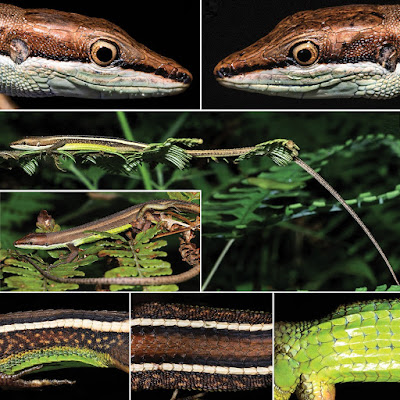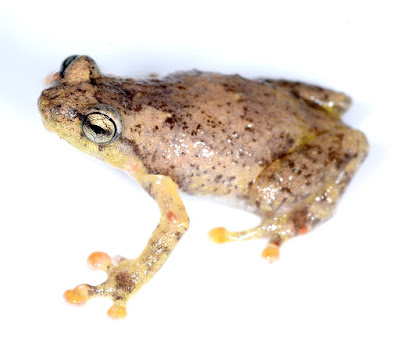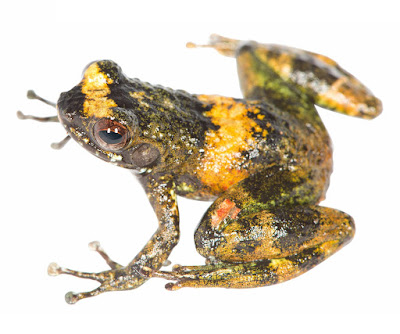[Most Recent Entries] [Calendar View]
Thursday, August 15th, 2019
| Time | Event | ||||||||
| 3:41a | [Herpetology • 2019] Takydromus yunkaiensis • A New Species of the Genus Takydromus (Squamata, Lacertidae) from southwestern Guangdong, China
Abstract A new species, Takydromus yunkaiensis J. Wang, Lyu, & Y.Y. Wang, sp. nov. is described based on a series of specimens collected from the Yunkaishan Nature Reserve located in the southern Yunkai Mountains, western Guangdong Province, China. The new species is a sister taxon to T. intermedius with a genetic divergence of 8.0–8.5% in the mitochondrial cytochrome b gene, and differs from all known congeners by a combination of the following morphological characters: (1) body size moderate, SVL 37.8–56.0 mm in males, 42.6–60.8 mm in females; (2) dorsal ground color brown; ventral surface green to yellow-green, but light blue-green on chin and throat, posteriorly green in adult males; (3) dorsolateral lines paired, strikingly yellowish-white bordered by black above and below, invisible or indistinct in juveniles and adult females; (4) flanks of body blackish brown with light brown marks in adult males; (5) presence of four pairs of chin-shields; (6) four supraoculars on each side; (7) presence of a row of supracilary granules that separate supracilaries from supraoculars; (8) two postnasals; (9) enlarged dorsal scales in six longitudinal rows on trunk of body, with strong keel; (10) enlarged ventral scales in six longitudinal rows, strongly keeled in males, smooth but outermost rows weakly keeled in females; (11) enlarged and keeled lateral scales in a row above ventrals; (12) femoral pores 2–3 on each side; (13) subdigital lamellae 20–23 under the fourth finger, 23–30 under the fourth toe; and (14) the first 2–3 subdigital lamellae under the fourth toe divided. The discovery of Takydromus yunkaiensis sp. nov. brings the total number of species of this genus to 24, of which nine occur in mainland China. Keywords: grass lizard, southern China, species diversity, taxonomy, Takydromus yunkaiensis sp. nov. Takydromus yunkaiensis J. Wang, Lyu & Y.Y. Wang, sp. nov. Diagnosis: (1) body size moderate, SVL 37.8–56.0 mm in males, 42.6–60.8 mm in females; (2) dorsal ground color brown; ventral surface green to yellow-green, but light blue-green on ventral head and neck, posteriorly green in adult males; (3) dorsolateral lines paired, strikingly yellowish-white bordered by black above and below, invisible or indistinct i n juveniles and adult females; (4) flanks of body blackish brown with light brown marks in adult males; (5) the presence of four pairs of chin-shields; (6) four supraoculars on each side; (7) presence of a row of supracilary granules that separate supracilaries from supraoculars; (8) two postnasals; (9) enlarged dorsal scales with strong keel in six longitudinal rows on trunk of body; (10) enlarged ventral scales in six longitudinal rows, strongly keeled in males, smooth but outermost rows weakly keeled in females; (11) enlarged and keeled lateral scales in a row above ventrals; (12) femoral pores 2–3 on each side; (13) subdigital lamellae 20–23 under the fourth finger, 23–30 under the fourth toe; and (14) the first 2–3 subdigital lamellae under the fourth toe divided. Etymology: The specific epithet, yunkaiensis, is in reference to the type locality of the new species. We propose the standard name “Yunkai grass lizard” and the Chinese name “Yun Kai Cao Xi (云开草蜥)”. Jian Wang, Zhi-Tong Lyu, Chen-Yu Yang, Yu-Long Li and Ying-Yong Wang. 2019. A New Species of the Genus Takydromus (Squamata, Lacertidae) from southwestern Guangdong, China. ZooKeys. 871: 119-139. DOI: 10.3897/zookeys.871.35947 | ||||||||
| 3:51a | [Ichthyology • 2019] Eigenmannia sirius • A New Species of Eigenmannia Jordan & Evermann (Gymnotiformes: Sternopygidae) from rio Tapajós, Brazil, with Discussion on Its Species Group and the Myology within Eigenmanniinae
Abstract A new species of Eigenmannia is described from the rio Mutum, tributary of upper rio Juruena, rio Tapajós basin, Comodoro, Mato Grosso, Brazil. The new species is distinguished from all congeners by coloration pattern, position of the mouth, number of scales rows above lateral line, number of premaxillary and dentary teeth, number of precaudal vertebrae, orbital diameter, mouth width, relative depth of posterodorsal expansion on infraorbitals 1+2 and relative size of coronomeckelian bone. Comments on potentially useful characters in phylogenetic studies derived from musculature, discussion on Eigenmannia species-group and the first dichotomous key for Eigenmannia are provided.
Eigenmannia sirius, sp. nov. Diagnosis: Eigenmannia sirius is diagnosed from all putative congeners with exception of Eigenmannia trilineata species-group (sensu [Peixoto, et al., 2015]), by the presence of superior midlateral stripe (vs. absence). The new species differs from all species of the Eigenmannia trilineata species-group, except E. besouro, E. correntes, E. vicentespelaea, and E. waiwai, by the subterminal mouth (vs. terminal). It differs from E. besouro, E. correntes, E. vicentespelaea, and E. waiwai by relative depth of posterodorsal expansion on infraorbitals 1+2 corresponding to 70% length of infraorbitals 1+2 (Fig 2—vs. 40% in E. besouro, E. correntes and E. waiwai, and approximately equals total length of infraorbitals 1+2 in E. vicentespelaea), and in having 15 precaudal vertebrae (vs. 14 in E. besouro and E. correntes, 13–14 in E. vicentespelaea and 12–13 in E. waiwai). Eigenmannia sirius can be differentiated from E. besouro by the origin of the superior midlateral stripe at vertical between base of 23rd to 31st anal-fin ray (vs. origin at vertical between 5th to 15th anal-fin ray). The new species is also diagnosed from E. correntes by the eye diameter (17.2–23.8% HL vs. 10.6–13.3% HL), and by the mouth width (13.1–22.4% HL vs. 23.5–26.0% HL). Eigenmannia sirius is further distinguished from E. vicentespelaea and E. waiwai by having 15–24 premaxillary teeth (Fig 3A vs. 25–26 and 35–40, respectively) and 15–33 dentary teeth (Fig 3B vs. 38–45 and 37–38, respectively). It additionally differs from E. vicentespealea by having 9–12 scale rows above lateral line (vs. seven or eight) and the coronomeckelian bone corresponding to 20–25% of length of Meckel’s cartilage (Fig 3B vs. 45%). The new species can be distinguished from Archolaemus species by the eye completely covered by thin membrane (vs. a free orbital rim); from Distocyclus by the rounded snout in profile (vs. conical snout); from Japigny by the absence of alternating dark bands on flanks (vs. presence); and from Rhabdolichops by the region above the lateral line on the anterior portion of the body covered by scales (vs. absence of scales above the lateral line on the anterior portion of the body). Etymology: The specific epithet sirius is an allusion to the alpha star of the Canis Major constellation that represents the state of Mato Grosso in the Brazilian national flag, a reference of the state of occurrence of the new taxon. A noun in apposition.
Distribution and habitat: Eigenmannia sirius is currently known only from rio Mutum, a tributary of the upper rio Juruena, rio Tapajós basin, Comodoro, Mato Grosso, Brazil (Fig 9). The type-locality is 502 m above sea level at the Chapada dos Parecis plateau. It is a clearwater river up to c. 3–6 m wide and 0.5–2.5 m deep, preserved riparian vegetation, swift current, and sand, pebbles and dead leaves on the bottom (Fig 10). Several types of microenvironment were sampled exhaustively, but E. sirius was captured only between root and subaquatic vegetation. Other species sampled syntopically were Aequidens cf. rondoni (Miranda Ribeiro), Erythrinus erythrinus (Bloch & Schneider), Hemigrammus skolioplatus Bertaco & Carvalho, Hyphessobrycon hexastichos Bertaco & Carvalho, H. melanostichos Carvalho & Bertaco, Hasemania nambiquara Bertaco & Malabarba, and Hoplerythrinus unitaeniatus (Spix & Agassiz). No other Gymnotiformes were collected with E. sirius. Luiz Antônio Wanderley Peixoto and Willian M. Ohara. 2019. A New Species of Eigenmannia Jordan & Evermann (Gymnotiformes: Sternopygidae) from rio Tapajós, Brazil, with Discussion on Its Species Group and the Myology within Eigenmanniinae. PLoS ONE. 14(8): e0220287. DOI: 10.1371/journal.pone.0220287 | ||||||||
| 7:03a | [Herpetology • 2019] Cophyla fortuna • the Lucky Cophyla (Microhylidae, Cophylinae), A New Arboreal Frog from Marojejy National Park in north-eastern Madagascar
Abstract We describe a new species of arboreal microhylid frog from northern Madagascar. The new species is assigned to the genus Cophyla based on molecular phylogeny and morphological similarities to other species of this genus. Molecular phylogenetic analysis resolved Cophyla fortuna sp. nov. as closely related to C. noromalalae. However, the two species were reciprocally monophyletic both in a tree reconstructed from a combination of mitochondrial genes, and in a tree based on the nuclear RAG-1 gene. The new species, previously identified as candidate species Cophyla sp. Ca4, occurs in lowland bamboo forests around the Marojejy Massif in northeastern Madagascar. It differs from the allopatric C. noromalalae, so far only known from the Montagne d’Ambre Massif in northern Madagascar, by slightly smaller body size and shorter duration and higher spectral frequency of advertisement calls. Several additional genetically divergent mitochondrial lineages of Cophyla, related to the C. fortuna/noromalalae complex and to C. phyllodactyla, occur in intervening areas between Montagne d’Ambre and Marojejy, and their status requires further study. Keywords: Amphibia, Anura, Cophyla fortuna sp. nov., Cophyla noromalalae Cophyla fortuna sp. nov. Andolalao Rakotoarison, Mark D. Scherz, Molly C. Bletz, Jary H. Razafindraibe, Frank Glaw and Miguel Vences. 2019. Description of the Lucky Cophyla (Microhylidae, Cophylinae), A New Arboreal Frog from Marojejy National Park in north-eastern Madagascar. Zootaxa. 4651(2); 271–288. DOI: 10.11646/zootaxa.4651.2.4 | ||||||||
| 9:22a | [Herpetology • 2019] Psammophis afroccidentalis • On the Psammophis sibilans group (Serpentes, Lamprophiidae, Psammophiinae) North of 12°S, with the Description of A New Species from West Africa
Abstract Based on molecular, morphological and field data, the status and zoogeography of the taxa of the Psammophis sibilans group north of 12°S are reviewed. Molecular data including sequences from 20 of the 22 described species known to occur north of 12°S suggest that P. sibilans distribution is restricted to northeastern Africa, from Egypt to Ethiopia. Populations from West Africa are described as a new species, Psammophis afroccidentalis sp. nov., and those from Chad, Cameroon and Central African Republic are assigned to P. rukwae which is also distributed from Tanzania to Ethiopia. Molecular data indicate the occurrence within this complex of three additional cryptic species in the Horn of Africa. Populations previously assigned to P. phillipsi in Central Africa north, south and east of the Congo forest block are assigned to P. mossambicusand the status of P. occidentalis is discussed. P. phillipsi is restricted to West Africa, with P. irregularis as junior synonym. Key words. Reptilia, Ophidia; Psammophiinae, Psammophis sibilans, Psammophis afroccidentalis sp. nov., taxonomy, biogeography, Africa.
PSAMMOPHIS AFROCCIDENTALIS Trape, Böhme & Mediannikov, sp. nov. West-African Whip Snake, Psammophis ouest-africain, Westafrikanische Sandrennnatter Diagnosis. Distinguishable from other species of the P. sibilans group by the combination of the following characters: 17 scale rows around midbody, 156–185 ventrals, 96–120 subcaudals (rarely less than 100), cloacal divided, 5 infralabials in contact with anterior sublinguals (very rarely 4). Dorsum pale brown, dark brown or greenish-brown, rarely uniform, usually a vertebral chain with the scale of vertebral row paler at base, but this chain often restricted to part of the dorsum, ill-defined and occasionally totally absent; pale dorsolateral stripes on the 4th row of dorsals, but often ill-defined or absent; top of head with a pale median stripe on the snout which forks when reaching the frontal and then borders the frontal, but often ill defined or absent in adults. Genetically diagnosable through possession of unique mitochondrial haplotypes. Psammophis afroccidentalis sp. nov. can be distinguished from P. rukwae by a higher number of subcaudals (P. rukwae 70–100, exceptionnaly up to 105), from P. sibilans by major differences in mitochondrial haplotypes, a pale median stripe that borders the frontal (not bordering the frontal in P. sibilans) and a more uniform dorsal colouration in most specimens, from P. schokari and P. aegyptius by a lower number of subralabials (8 versus 9) and a different head pattern, and from P. sudanensis, P. phillipsi, P. occidentalis, P. mossambicus, P. leopardinus, P. zambiensis and P. subtaeniatus by a higher number of infralabials in contact with the anterior sublinguals (5 versus 4) and by different head and dorsal patterns. Habitat. Sahel and Sudan savanna in West Africa. Penetrates in Guinea savanna and relict populations in Sahelo-Saharan wetlands. Distribution. Mauritania (northernmost record: Tidra island 19°44’N, 16°24’W), Senegal, Gambia, Guinea Bissau, Guinea, Mali (northenmost record: Tinjemban 16°44’N, 02°50’W and along the Niger River), Ivory Coast, Burkina Faso, Ghana, Togo, Benin, Niger (northernmost record: Azzel 17°03’N, 08°03’E), Nigeria and Chad (Mao). Possibly a relict population in southern Algeria (ZFMK 29365 from 200 km north of Tamanrasset, a damaged specimen previously assigned to P. rukwae by Böhme 1986 and to P. sibilans by Hughes 2012). Jean-François Trape, Pierre-André Crochet, Donald G. Broadley, Patricia Sourouille, Youssouph Mané, Marius Burger, Wolfgang Böhme, Mostafa Saleh, Anna Karan, Benedetto Lanza and Oleg Mediannikov. 2019. On the Psammophis sibilans group (Serpentes, Lamprophiidae, Psammophiinae) North of 12°S, with the Description of A New Species from West Africa. Bonn zoological Bulletin. 68(1); 61–91. DOI: 10.20363/BZB-2019.68.1.061 | ||||||||
| 10:01a | [Herpetology • 2019] Species Complexes and the Importance of Data Deficient Classification in Red List Assessments: The Case of Hylobatrachus Frogs [Mantidactylus (Hylobatrachus) atsimo & M. (H.) petakorona]
Abstract Taxonomy is the cornerstone of extinction risk assessments. Currently, the IUCN Red List treats species complexes either under a single overarching species name—resulting in an unhelpfully broad circumscription and underestimated threat assessment that does not apply to any one species lineage—or omits them altogether—resulting in the omission of species that should be assessed. We argue that taxonomic uncertainty alone, as in species complexes, should be grounds for assessment as Data Deficient (DD). Yet, use of the DD category is currently discouraged, resulting in assessments based on poor data quality and dismissal of the importance of taxonomic confidence in conservation. This policy may be leading to volatile and unwarranted assessments of hundreds of species across the world, and needs to be revised. To illustrate this point, we here present a partial taxonomic revision of torrent frogs from eastern Madagascar in the Mantidactylus subgenus Hylobatrachus. Two named species, Mantidactylus (Hylobatrachus) lugubris and M. (H.) cowanii, and several undescribed candidate species are recognised, but the application of the available names has been somewhat ambiguous. In a recent re-assessment of its conservation status, M. (H.) lugubris was assessed including all complex members except M. (H.) cowanii within its distribution, giving it a status of Least Concern and distribution over most of eastern Madagascar. After describing two of the unnamed lineages as Mantidactylus (Hylobatrachus) atsimo sp. nov. (from southeastern Madagascar) and Mantidactylus (Hylobatrachus) petakorona sp. nov. (from the Marojejy Massif in northeastern Madagascar), we show that Mantidactylus (Hylobatrachus) lugubris is restricted to the central east of Madagascar, highlighting the inaccuracy of its current Red List assessment. We propose to re-assess its status under a more restrictive definition that omits well-defined candidate species, thus representing the actual species to which its assessment refers, to the best of current knowledge. We recommend that for species complexes in general, (1) nominal lineages that can be confidently restricted should be assessed under the strict definition, (2) non-nominal species-level lineages and ambiguous names should be prioritised for taxonomic research, and (3) ambiguous names should be assessed as DD to highlight the deficiency in data on their taxonomic status, which is an impediment to their conservation. This would reduce ambiguity and underestimation of threats involved in assessing species complexes, and place the appropriate emphasis on the importance of taxonomy in anchoring conservation. Mark D. Scherz, Frank Glaw, Carl R. Hutter, Molly C. Bletz, Andolalao Rakotoarison, Jörn Köhler and Miguel Vences. 2019. Species Complexes and the Importance of Data Deficient Classification in Red List Assessments: The Case of Hylobatrachus Frogs. PLoS ONE. 14(8): e0219437. DOI: 10.1371/journal.pone.0219437 |
| << Previous Day |
2019/08/15 [Calendar] |
Next Day >> |

















